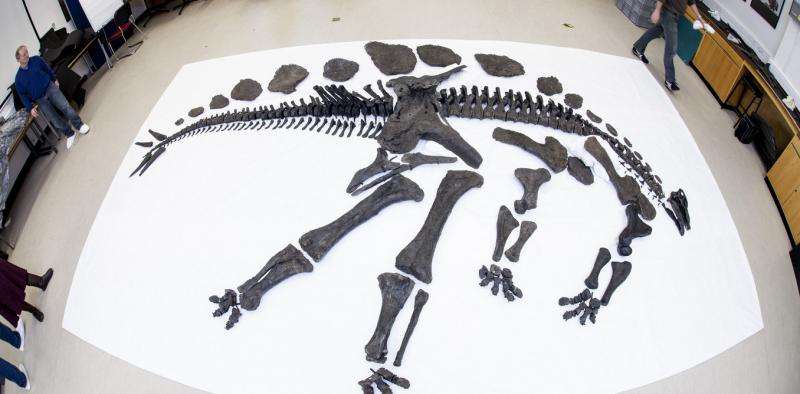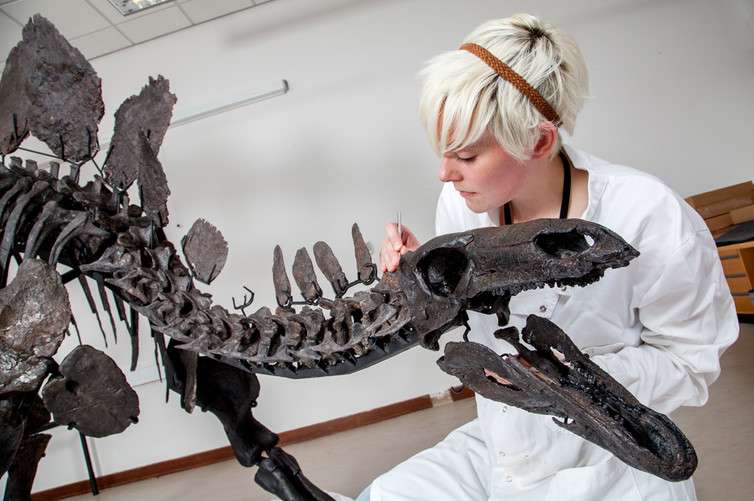How to flat-pack a dinosaur

After more than 100 years of residency in London's Natural History Museum, the world famous cast of a Diplodocus carnegii skeleton, known as "Dippy", is going on tour to inspire and educate more people than ever before.
The prospect of moving a world-famous museum specimen like Dippy is a daunting one and presents a unique set of challenges. And behind the tour of the 21.3 metre-long sauropod superstar to museums, community centres and even cathedrals, will be an entourage of handlers, fixers and "make-up artists" to ensure everything goes smoothly.
It may sound like a rather obvious statement but moving a giant dinosaur is not an easy task. I saw this for myself last year when I was lucky enough to film with David Attenborough in Argentina. We joined Diego Pol and his team from the Museo Paleontologico Egidio Feruglio after the discovery and excavation of seven skeletons belonging to a brand new species, a type of titanosaur that later turned out to be the largest of all the dinosaurs.
Of course I marvelled at the 8ft-long femurs and vertebrae almost as tall as myself. But what surprised me more were the methods by which the team secured and transported the 140m-year-old fossilised bones. After the team used mechanical diggers and noisy pneumatic drills to remove the hundreds of tonnes of sand and rock, they swapped for trowels and brushes to tenderly separate the fossils from their surroundings.
Then, in order to transport the fossils, each one was wrapped in wet toilet roll. Yes, toilet roll. Hundreds and hundreds of metres went into wrapping up each specimen. There was so much loo roll that you could cover a football pitch with the stuff. It allowed the team to wrap the fossils with a soft protective membrane that would cover the delicate contours perfectly.
Plaster of Paris was then added, layer by layer. Although fossils are made of rock, they can be surprisingly fragile and need to be protected. Each one was then lifted onto the back of a truck and transported back to the museum, some four or five hours away by road. Only there wasn't a road for much of the first part of the journey, so the team actually had to construct a road to transport the precious cargo safely.
Fossils are moved and transported for a variety of reasons, and are always done so with the utmost of care. Isla Gladstone is senior curator for the Natural Sciences collections at the Bristol Museum & Art Gallery and is responsible for a huge fossil specimen going on show this year. "We're currently preparing to display the fossil skeleton of an 8m-long pliosaur for an exhibition this summer," she told me.
"Work to move it began after its discovery in a clay pit in 1994. The museum helped excavate huge blocks of rock containing its bones and removed them using diggers and fork-lifts. Ten years' delicate work followed to chip away the rock and release over 100 fossil pieces."

Delicate operation
It is clear that excavating fossils is a delicate and risky task but this is only half the work that needs to be done. The actual articulation of the fossil bones to create an impressive 3-D jigsaw-like display is equally tricky.
Made up of 292 bones, Dippy is actually a plaster cast of the original skeleton, rather than the fossils themselves. While it may be easy to think that Dippy is a cast and not a "real" skeleton, the cast is still hugely important in its own rights.
Palaeontologist and renowned fossil preparator Nigel Larkin believes that the biggest problem with Dippy is not just the size but the age and material of the casts. "I was involved in dismantling the tail and replacing the rear legs when the tail was raised off the floor in the mid 1990s," he said. "The casts are very old and made of plaster. That means they are now very brittle."
Casts should, and normally do, have the same status as real fossils and are specimens in their own right. Often, a cast is all you have available to study, as the original may be on the other side of the world. And in some cases, the actual fossil has actually subsequently been lost or destroyed.
Larkin says that mounting the actual fossils is no easier, as they are typically fragile and very heavy. "The ethics of mounting fossils in museums mean that no holes can be drilled in to them. They have to be held in position securely with external materials, lined with (specialised) archival foam where it would otherwise touch the fossil."
But museums still want any mounted dinosaur to actually look good, and Steve Brusatte (a palaeontologist at the University of Edinburgh) believes this an equally important consideration. "The biggest problems with mounting fossils – particularly skeletons – is not just the sheer weight of the specimen but also making the mount-work as unobtrusive as possible," he said. "This is obviously a difficult balancing act both aesthetically and literally."
As Dippy hits the road and tours the UK, spare a thought about all the work that needs to go into excavating dinosaur fossils and mounting them or their casts. Making the casts is a whole story in itself, now involving lasers, robots and multi-bladed machines. Have a think the next time you're in a museum about how you would make sure the skeleton is both physically safe and looking as lifelike and inspiring as possible.
Provided by The Conversation
This article was originally published on The Conversation. Read the original article.![]()




















